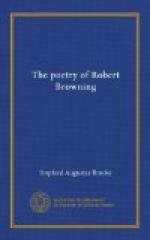This is the historical background of the poem, and in front of it are represented Sordello, his life, his development as an individual soul, and his death. I have, from one point of view, slightly analysed the first two books of the poem, but to analyse the whole would be apart from the purpose of this book. My object in this and the following chapter is to mark out, with here and there a piece of explanation, certain characteristics of the poem in relation, first, to the time in which it is placed; secondly, to the development of Sordello in contact with that time; and thirdly, to our own time; then to trace the connection of the poem with the poetic evolution of Browning; and finally, to dwell throughout the whole discussion on its poetic qualities.
1. The time in which the poem’s thought and action are placed is the beginning of the thirteenth century in North Italy, a period in which the religious basis of life, laid so enthusiastically in the eleventh century, and gradually weakening through the twelfth, had all but faded away for the mediaeval noble and burgher, and even for the clergy. Religion, it is true, was confessed and its dogmas believed in; the Cistercian revival had restored some of its lost influence, but it did not any longer restrain the passions, modify the wickedness, control the ambitions or subdue the world, in the heart of men, as it had done in the eleventh century. There was in Italy, at least, an unbridled licence of life, a fierce individuality, which the existence of a number of small republics encouraged; and, in consequence, a wild confusion of thought and act in every sphere of human life. Moreover, all through the twelfth century there had been a reaction among the artistic and literary men against the theory of life laid down by the monks, and against the merely saintly aims and practice of the religious, of which that famous passage in Aucassin and Nicolete is an embodiment. Then, too, the love poetry (a poetry which tended to throw monkish purity aside) started in the midst of the twelfth century; then the troubadours began to sing; and then the love-songs of Germany arose. And Italian poetry, a poetry which tended to repel the religion of the spirit for the religion of enjoyment, had begun in Sicily and Siena in 1172-78, and was nurtured in the Sicilian Court of Frederick II., while Sordello was a youth. All over Europe, poetry drifted into a secular poetry of love and war and romance. The religious basis of life had lost its strength.




